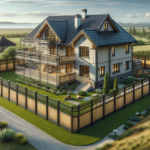Understanding the Importance of Home Fences
Fences serve multiple purposes in a home setting, from providing privacy and security to enhancing the aesthetic appeal of a property. The decision to install a fence can be driven by the need to create a safe space for children and pets, mark property boundaries, or simply add a decorative element to the landscape.
For many homeowners, privacy is a top priority. A well-constructed fence can act as a barrier against prying eyes, allowing you to enjoy your outdoor spaces without the feeling of being watched. Security is another crucial aspect; a sturdy fence can deter trespassers and provide a sense of safety.
Additionally, fences contribute to the overall curb appeal of a home. With a variety of materials and designs available, they can complement the architectural style of your home, adding value and charm. Whether you opt for the classic look of a wooden fence, the low-maintenance appeal of vinyl, or the modern touch of metal, each option can significantly enhance your property’s exterior.
Choosing the Right Material for Your Fence
When it comes to fence installation, selecting the right material is crucial. Each material offers different benefits and drawbacks, and understanding these can help you make an informed decision.
Wooden fences are popular for their natural beauty and versatility. They can be painted or stained to match your home’s color scheme and are relatively easy to install. However, they require regular maintenance to prevent rot and insect damage.
Vinyl fences are renowned for their durability and low maintenance. They do not require painting and are resistant to rot and pests. While they may have a higher initial cost than wood, their longevity and minimal upkeep make them a cost-effective choice in the long run.
Metal fences, such as those made from aluminum or steel, offer strength and security. They are less prone to damage and can withstand harsh weather conditions. Additionally, metal fences can be designed in various styles, from ornate to minimalist, to suit different tastes.
Cost-Effective Installation Tips
Installing a fence doesn’t have to break the bank. There are several strategies you can employ to keep costs down while still achieving a high-quality installation.
First, consider the size and scope of your project. A smaller fence or one that only encloses a portion of your yard will naturally cost less than a full perimeter fence. Additionally, opting for a simpler design can reduce labor and material costs.
Doing some of the work yourself can also save money. While you might need professional help for certain aspects, such as setting posts or ensuring proper alignment, tasks like painting or staining can be done on your own.
Finally, shop around for materials. Prices can vary significantly between suppliers, and buying in bulk or during sales can lead to substantial savings. Don’t hesitate to negotiate prices or ask for discounts, especially if you’re purchasing a large quantity of materials.
DIY vs. Professional Installation
Deciding whether to install a fence yourself or hire a professional is an important consideration. Each approach has its pros and cons, and the right choice depends on your skills, budget, and the complexity of the project.
DIY installation can be a rewarding project, offering a sense of accomplishment and potential cost savings. It allows you to work at your own pace and customize the fence to your liking. However, it requires a certain level of skill and knowledge, particularly for tasks such as measuring accurately and ensuring structural integrity.
On the other hand, professional installation guarantees expertise and efficiency. Experienced installers can handle complex designs and challenging terrains, ensuring a durable and aesthetically pleasing result. While this option may have a higher upfront cost, it can save time and prevent costly mistakes in the long run.
Maintenance and Longevity of Your Fence
Once your fence is installed, proper maintenance is key to ensuring its longevity and appearance. Different materials require different levels of care, and understanding these needs can help you keep your fence in top condition.
Wooden fences need regular treatment to protect against moisture and pests. Applying a sealant or stain every few years can prevent rot and maintain the wood’s natural beauty. Regular inspections for damage or loose boards are also essential.
Vinyl fences require minimal maintenance. A simple wash with soap and water can keep them looking new. It’s important to check for cracks or damage, especially after severe weather, and address any issues promptly.
Metal fences benefit from periodic cleaning to remove rust and debris. A rust-resistant coating can prevent corrosion, and any damaged areas should be repaired to maintain the fence’s strength and appearance.








